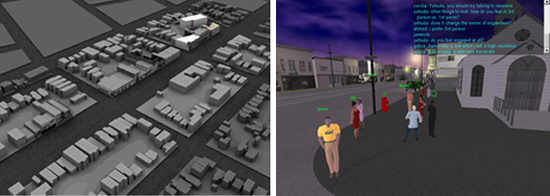|
3DVisA Resources
3DVisA Index of 3D Projects: Cultural Landscapes
West Oakland Jazz and Blues Clubs of the 1940s and 1950s
In the 1940s and 1950s, Seventh Street in West Oakland, California was lined with jazz clubs. They rivalled those of Harlem on the West Coast. The elegant Slim Jenkins Place, Esther's Orbit Room and
other clubs attracted some of the most legendary singers and musicians, including Jimmie Witherspoon, Sugar Pie DeSanto, B. B. King and Aretha Franklin. Although much music has survived in recordings,
the architectural, cultural and social parts of this important Afro-American heritage have all been lost, owing to drastic transformation of this part of the city.
The urban redevelopment from the mid 1960s onwards consisted of new road and rail schemes. This modernisation brought an end to the bursting commercial district and its vibrant music scene. The story of West Oakland's
jazz clubs was the subject of two documentary films, Crossroads: A Story of West Oakland and The Story of the Oakland Blues. Other accounts include newspaper reports, audio recordings and
photographs. To preserve this heritage, scholars and students from the University of California at Berkeley have gathered historic evidence and used it to recreate digitally the jazz club scene of the 1950s in West Oakland.

Fig. 1. Digital recreation of West Oakland Jazz and Blues Clubs of the 1940s and 1950s © University of California at Berkeley. Reproduced with kind permission.
The project draws on the experience of an earlier Virtual Reality visualisation of an ancient Egyptian city, called Living History. The virtual environment of West Oakland music clubs was created in 3DStudioMax. Much consideration was given, alongside the rendering and modelling of the built environment, to the construction
of narratives. This part of the project was informed by the concepts and processes used in theatre and computer games. The making of a virtual place was approached from a position that may be compared to staging a play.
Avatars acted as actors, the stage provided a context for the 'story' or a 'play'. The genre of video games was explored to provide possible models for the construction of the 'play'.
The simulation game, the multi-player game and the adventure game were examined and influenced the writing of interactive narratives based on accounts by the witnesses of
the historic events.
The project sought to answer two main questions pertaining to the digital preservation of cultural heritage: What is the 'appropriate' use of digital media in the
service of preserving cultural heritage? What is the impact of digital media on the content they purport to preserve and to communicate?
For discussion of these issues and further details of the project, see the article by Grabowicz and Kalay published on these pages.
Project dates: Started in 2006.
Resource status: Online computer game, Remembering 7th Street, free.
Contributors: Graduate students in the University of California at Berkeley Architecture Department and students in a class at
the UC Berkeley Graduate School of Journalism; guided by Professor Yehuda E. Kalay and Professor Paul Grabowicz; sponsored by the Center for New Media, University of California, Berkeley, USA.
Sources and further details:
Grabowicz, P. and Kalay, Y. E. (2006), 'Oakland Blues. Virtual Preservation of Seventh Street's 1950s' Jazz Scene',
3DVisA Bulletin, Issue 1, September.
Remembering 7th Street. The Oakland Jazz and Blues Clubs Virtual Reality Project, The project page (internal),
UC Berkeley Graduate School of Journalism.
Remembering 7th Street. Video Game Storytelling, talk podcast, Paul Grabowicz, UC Berkeley Graduate School of Journalism talks about producing a video game and how the tools and techniques to produce the game can be used as a form of storytelling. UC Berkeley, 22nd May 2006
Record based on the material kindly provided by Professor Yehuda E. Kalay and Professor Paul Grabowicz. Compiled by Anna Bentkowska-Kafel, 11 March 2007. Last updated: 17 January 2012..
© University of California at Berkeley and 3DVisA, 2006.
Back to the list of 3D projects
| 